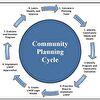Steps in the UWSF Planning Process
-
Organize a Planning Team
As the leader of the UWSF project, the local United Way should initiate the creation of a planning team that will guide Strengthening Families work. We recognize that the formality of this team will depend upon the amount of available resources, but at the core you need a group of people that believe in the Strengthening Families principles and are willing to commit an agreed upon amount of their time.
A United Way staff member should lead and coordinate this effort. It is critical that the community planning process is inclusive and that the appropriate UW staff, community partners, residents, and program participants are engaged early in the work. Begin assembling your team from inside your United Way. Include any individuals who have the interest, energy, and capacity to contribute to the work. It is also important that this group has the full support of your senior leadership so the work can be carried out successfully with the full support of the organization.
After engaging your United Way team members, you should reach out to your community partners, both individuals and organizations that are well aligned with the work of UWSF. Start with the people you think will understand and embrace the work and then expand your network as your project develops. Make sure that you include program participants and community residents on your team; these individuals can provide valuable expertise, can speak to residents' perspectives, and can encourage other parents and community members to become involved. Please refer to the Achieving Buy-in section for more detailed information on how to build your team.Keys to Success
- Before starting your formal planning process, orient all team members to the protective factors, how they are linked to positive outcomes for families, and how your local United Way can adapt to the UWSF framework. Establishing shared understanding from the outset will help ensure that your team members are on the same page.
- Some questions to help you identify possible team members are, Who will be most enthusiastic about the work? Who is likely to carry out this kind of work?
- Use this as an opportunity to engage experienced partners as well as new individuals and organizations that may expand the reach of your organization.
-
Identify Community Needs and Assets.
Your team's first task after orientation is to create an understanding of the key issues, needs, and assets in your community. The UWSF community assessment process will be different from most other approaches because it will require you to assess your community gaps, needs, and assets through the lens of the protective factors. Our sites have referred to this process as a "cross-walk", in which community needs, assets, and current program offerings are organized within each protective factor. For example ask
- What are the needs of families in our community relative to each of the protective factors?
- What are the strengths of families in our community relative to each of the protective factors?
- What community organizations are already working on issues related to the protective factors?
- What are the community assets that can be used to build protective factors?
- What are the resources or supports in our community that are not currently being provided to build the protective factors?
Community assessment can use a variety of data collection tools, including: focus groups, community cafes, community asset mapping, group reflections, and interviews. All of these methods should provide information that expands the group's understanding of the community and possible future actions. By systematically assessing needs and assets relative to the protective factors, the planning team can arrive at a firmer understanding of what is already being done and what should be done in the future.
Keys to Success
- You may find that there are those in your team who say, "We are already doing all of this." If this is the case, emphasize that UWSF offers a framework for helping them do what they do even better.
- As you conduct the "cross-walk", recognize that many programs will address multiple protective factors. In fact, more comprehensive programs may be part of the solution for families in your community.
- In considering which programs to highlight for future efforts, be sure to consider the quality of their offerings. It is not enough just to address a protective factor, but also to address it well and thoroughly.
-
Identify Program Outcomes, System Outcomes, and Community Outcomes.
Planners frequently advise starting "with the end in mind." In the case of UWSF, this means identifying the ways in which the local United Way can help partners and community providers identify desired outcomes and changes. The outcomes you are trying to achieve are changes in participating families and the community as a result of your efforts and the efforts of your partners. The long-term desired outcomes of this work are typically that families are strengthened, protective factors are increased, and fewer children are abused and neglected. On the way to these larger outcomes, you may also wish to measure related concepts such as family functioning, parental stress, social support, and parent-child interaction.
United Way Worldwide addresses: System Outcomes. How are organizations, partners, and systems changing as a result of the work? For example:- Community agencies will collaborate on family strengthening efforts.
- Partner organizations will incorporate UWSF language and principles into their programs.
- Local agencies will shift more to a families strengthening approach to preventing child abuse and neglect.
Program Outcomes
Participants will change as a result of programming. Evaluating this includes answering how participants change as a result of the efforts? For example:
- Participants in certain UWSF@Work initiatives will have reduced parental stress as a result of learning parenting skills and parental resilience.
- Parents in all home visiting programs will enact non-punitive discipline strategies.
Community Outcomes
These are the benefits for specific groups of people in the community that come about through changes in the community itself—changes in organizations, systems, neighborhoods, and networks. How does the community benefit from the collective efforts? This would not be measured in the initiative because of the various challenges and lack of support for doing so; however, community outcomes and impact would guide planning:
- Children in poverty will start kindergarten with age-appropriate pre-literacy skills.
As you identify possible outcomes, it will be helpful to consider the actual instruments you will recommend programs that can be used to measure positive parenting and strong families. The FRIENDS Protective Factors Survey is an excellent starting point. This instrument is a pre/post survey that is designed to be used with caregivers who are participating in programs designed to strengthen parenting and prevent child abuse and neglect.
Keys to Success
- Before you have your partners and programs begin the evaluation process, remind them to obtain consent from their participants. The participants should understand what it is that they are being asked to do.
- If you will be developing, designing, or redesigning specific evaluation tools or instruments, ensure that the design is "user friendly." This would include instructions that are descriptive, font size that is easily readable, and a uniform appearance.
- The outcomes you identify in Step 3 should be carried over into your Logic Model (Step 5). You may need to revise your outcomes based on the more intensive thinking associated with the logic model.
-
Prioritize "Ways to Implement UWSF".
This website includes descriptions of a set of approaches for carrying out UWSF work that is entitled "Ways to Implement UWSF." From this list, local United Ways select which approaches align with the program outcomes, community outcomes, and community changes identified in Step 3. If it is not possible to align the outcomes with the approaches, then you may need to consider new outcomes or develop new ways to implement UWSF.
- How well the approach fits with the community needs identified in Step 2.
- What gaps have been identified in your community assessment?
- What desired outcomes have been identified in Step 3?
- To what extent does the rationale make sense to your planning team?
- Which approaches seem to be most feasible given the strengths of your community and your local United Way?
In your first year of work, it is probably best to choose two or three approaches so your work is not too dispersed. It is important that the group identify what make the most sense to the community and what has the greatest likelihood of success in the early stages of the project. In prioritizing and choosing the approaches to be taken, important considerations include:
The basic rationale for each approach is shown in the following table:
| Ways to Implement UWSF | Rationale |
|---|---|
| UWSF@Work | Because businesses are natural partners of United Way and they employ many families that could use support, the workplace is a promising place for embedding strengthening families. UWSF@Work represents the bridge between families and workplaces, including the local United Way and other community agencies. |
| 2-1-1 | The 2-1-1 resource and referral system is a tool for connecting families to needed resources. By training 2-1-1 staff on the importance of protective factors and integrating this language into the 2-1-1 system, you can increase the community's understanding of the resources available and/or needed to strengthen families and prevent abuse and neglect. |
| Allocation Process | Your allocation process represents a leverage point for influencing community activities. By focusing your allocation process on strengthening families, you can leverage greater integration of protective factors in the programs and services your United Way supports. |
| Community Cafes | Community cafés are an assets-based, facilitated conversation process that assists in engaging parents and other community members as partners. Led by parent facilitators, the cafes can be used to identify key issues for parents, identify parent leaders and to build relationships among parents and other community partners, such as schools, libraries or early childhood programs. |
| Marketing | Local United Ways can incorporate the language of UWSF into your communications with diverse members of your community to increase public awareness about the need for and benefits of strengthening families and promoting optimal child development. You can also work with your Resource Development partners to create Strengthening Families products that appeal to donors, volunteers and advocates in your community. |
| Resource Development | UWSF is a natural for United Way product development. Not only are there specific outcomes from this work that lead toward organizational goals in education, income, and health, but this work also offers opportunities to serve employees and employers at work. This increased visibility at the workplace can lead to increased awareness of the value of United Way, which could lead to more support for building on and expanding this work. |
| Self-Assessment | The self-assessment tool will guide you and your community partners through a deeper reflection about how to deliver programming in family-strengthening ways. The process typically leads to a much deeper understanding of UWSF and creates the foundation for more intensive strategic planning. |
| Training | Training is typically used with partners that want to or have capacity to work on strengthening families, such as sharing the protective factors framework with nonprofit organizations, volunteers and/or employers. The intent is to build local capacity to carry out family strengthening work and is sometimes carried out within a certification framework. |
Keys to Success
- In the early phases of your project, focus on just a few approaches so you do not spread your efforts too thin.
- Think about which approaches will have the most impact in your community.
- Find ways to celebrate early successes and use these successes to publicize the progress you are making.
- Remember that planning is a dynamic process and you will be adjusting and adapting your plan over time to meet new and emerging needs and realities.
-
Create a UWSF Logic Model.
A logic model can be defined as "a systematic and visual way to present and share your understanding of the relationships among the resources you have to operate your program, the activities you plan to do, and the changes or results you hope to achieve" (Kellogg Foundation, 2004, p.1). Logic models have many purposes, including:
- Making your underlying beliefs explicit,
- Challenging assumptions and strengthening logic,
- Communicating the initiative's essential purpose to broad audiences, and
- Making the case for more financial investment. (Kellogg Foundation, 2004).
We have provided a logic model template and two sample logic models prepared by two local United Ways in their Strengthening Families work.
The outcomes that you identified in Step 3 of the Planning stage are the foundation for your logic model. In essence, the logic model requires you to identify short-term, intermediate, and long-term outcomes, along with the resources, activities and strategies, and target audiences for your effort. Good logic models also incorporate strong thinking about how and why your approach will likely produce the intended outcomes. The development of a logic model is an excellent way to make sure the planning team has a shared understanding of what the approach will be; the logic model can also serve as a guide for how well you are implementing your approach (Planning step 6) and what aspects of the program you will want to evaluate (Planning step 7).
The major elements of a logic model are the following (see the Resources section for outstanding logic model sources):
- Inputs. Most logic models reference "inputs", but what we really mean is resources that are necessary to make your program or initiative a reality. This can include funding, personnel time, equipment, necessary partnerships, and so on.
- Activities. The activities you list define what your project or initiative will do. In the case of UWSF, your activities should be closely aligned to the approaches you have selected. If training is a primary focus, then the activities should be training-related.
- Outputs. Outputs refers to two things: (1) products or deliverables that are created to accomplish your activities (this can include things like classes taught and curricula developed); and (2) participation and engagement, which refers to who is served, as well as how and why they are engaged. This should include your target audience, as well as some understanding of their motivation to be engaged.
-
Outcomes.
Outcomes are the changes that take place in your target population and should have been identified in Step 3 above. It is important that these outcomes be phrased in terms of how people change (not what we do for people). Outcomes can be broken down into short-term, intermediate, and long-term, with some logical understanding of what outcomes lead to longer-term outcomes. In United Way, this is often referred to as the "chain of outcomes." These outcomes include changes in people such as knowledge, attitudes, awareness, behaviors, and new practices.
Create an Evaluation Plan.
The evaluation plan should be developed in concert with the logic model. The logic model should include measurable outcomes, including both process questions (related to resources, program delivery, audience engagement, etc.) and outcome questions (Is the program achieving its intended outcomes?). As you create the logic model, you can also define how you will evaluate each element in the model. We recommend that you use the University of Wisconsin created "Planning a Program Evaluation" and accompanying worksheet to guide the development of your evaluation plan.
- Engaging Stakeholders: If you engaged the right people in your Community Planning Team, then you have already engaged the proper stakeholders; however, you may wish to revisit this issue in the context of evaluation to determine if any new stakeholders should be engaged.
- Focusing the Evaluation: At this point, you should clarify: (1) the purpose of the evaluation; (2) the intended users of the evaluation; (3) the evaluation questions; (4) the indicators that will help you answer your questions; and (5) the evaluation design you will use. You should also reconsider the measures and instruments identified in Step 3 of the Planning stage.
- Collecting the Information: You will need to decide how you will collect the data to answer your questions and also clarify how you will manage the information you are collecting.
- Analyzing and Interpreting the Information: In this portion of the plan, you will identify: (1) how the data will be analyzed; and (2) who will analyze the information.
- Using the Information: Because you identified intended users earlier, it should be easier to think about how you will use the information. You will decide: (1) who to share the information with; (2) how to share the information with various groups; and (3) how to use the information for reporting outcomes and improving the project.
Based on the above Wisconsin Cooperative Extension worksheet, the key steps to developing an evaluation plan are:
With this evaluation plan in hand, you have a better chance to proceed with an evaluation approach that is both thoughtful and useful.




